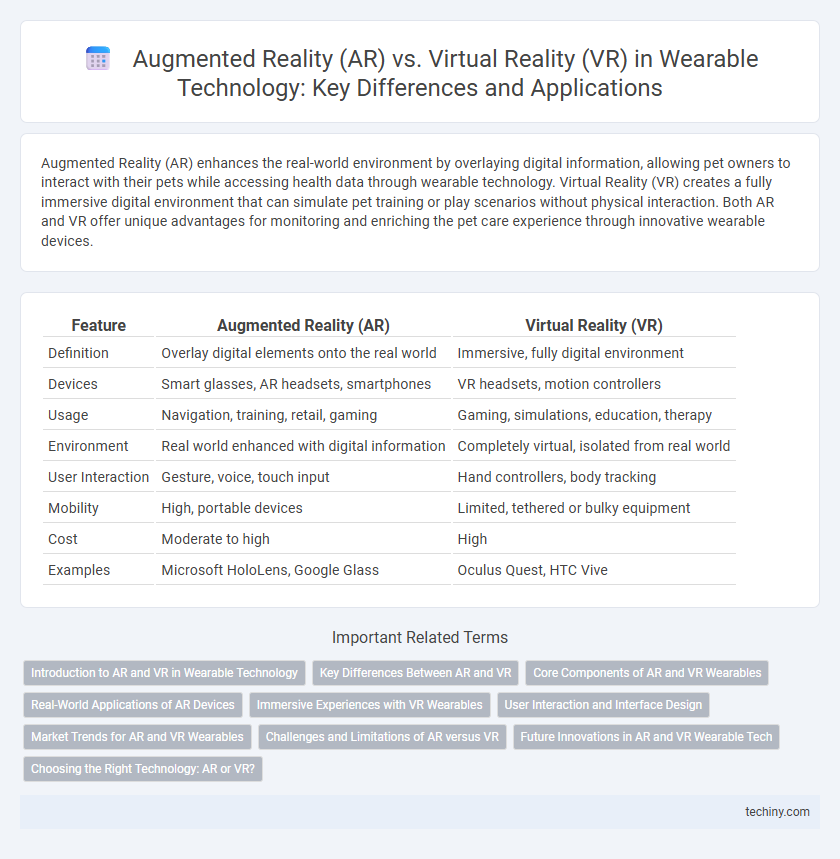Augmented Reality (AR) enhances the real-world environment by overlaying digital information, allowing pet owners to interact with their pets while accessing health data through wearable technology. Virtual Reality (VR) creates a fully immersive digital environment that can simulate pet training or play scenarios without physical interaction. Both AR and VR offer unique advantages for monitoring and enriching the pet care experience through innovative wearable devices.
Table of Comparison
| Feature | Augmented Reality (AR) | Virtual Reality (VR) |
|---|---|---|
| Definition | Overlay digital elements onto the real world | Immersive, fully digital environment |
| Devices | Smart glasses, AR headsets, smartphones | VR headsets, motion controllers |
| Usage | Navigation, training, retail, gaming | Gaming, simulations, education, therapy |
| Environment | Real world enhanced with digital information | Completely virtual, isolated from real world |
| User Interaction | Gesture, voice, touch input | Hand controllers, body tracking |
| Mobility | High, portable devices | Limited, tethered or bulky equipment |
| Cost | Moderate to high | High |
| Examples | Microsoft HoloLens, Google Glass | Oculus Quest, HTC Vive |
Introduction to AR and VR in Wearable Technology
Augmented Reality (AR) in wearable technology enhances the user's environment by overlaying digital information onto real-world views, enabling interactive experiences through devices like smart glasses and AR headsets. Virtual Reality (VR) creates fully immersive digital environments via head-mounted displays, isolating users from the physical world for gaming, training, and simulation purposes. Both AR and VR leverage advanced sensors and processors in wearables to deliver seamless, real-time interactions, transforming industries from healthcare to entertainment.
Key Differences Between AR and VR
Augmented Reality (AR) overlays digital information onto the real world, enhancing user interaction with their natural environment through devices like smart glasses and smartphones. Virtual Reality (VR) creates an entirely immersive digital environment that replaces the real world, utilizing headsets such as Oculus Rift or HTC Vive for full sensory engagement. Key differences include AR's integration with real-world settings versus VR's full immersion, and AR's reliance on transparent displays compared to VR's opaque, immersive screens.
Core Components of AR and VR Wearables
Augmented Reality (AR) wearables primarily integrate transparent displays, sensors, and cameras to overlay digital content onto the physical environment, enabling real-time interaction with surrounding elements. Virtual Reality (VR) wearables consist mainly of immersive headsets with high-resolution displays, motion sensors, and spatial audio systems designed to fully transport users into a virtual environment. Both AR and VR devices rely on advanced processors and connectivity modules to deliver seamless augmented or immersive experiences.
Real-World Applications of AR Devices
Augmented Reality (AR) devices enhance real-world environments by overlaying digital information, enabling applications in fields like healthcare for surgical precision, manufacturing for maintenance support, and retail with interactive product displays. Unlike Virtual Reality (VR), which creates entirely immersive digital experiences, AR maintains user awareness of their physical surroundings while integrating contextual data. Industries leverage AR headsets and smart glasses to improve operational efficiency, training, and customer engagement through real-time, situational insights.
Immersive Experiences with VR Wearables
Virtual Reality (VR) wearables deliver fully immersive experiences by transporting users into entirely computer-generated environments, enhancing sensory engagement through advanced headsets and motion tracking. Augmented Reality (AR) overlays digital elements onto the real world, offering interactive but less immersive experiences compared to VR's complete virtual immersion. VR wearables are instrumental in gaming, training simulations, and virtual tourism, where full environmental immersion intensifies user engagement and realism.
User Interaction and Interface Design
Augmented Reality (AR) enhances real-world environments by overlaying digital content through devices like smart glasses, requiring intuitive, context-aware user interfaces that blend physical and virtual elements seamlessly. Virtual Reality (VR) immerses users in fully virtual environments using headsets, demanding highly responsive interfaces with spatial tracking and hand gesture recognition to support natural interaction within 3D spaces. Effective interface design for both AR and VR prioritizes ergonomic controls, real-time feedback, and minimal latency to ensure smooth, engaging user experiences in wearable technology applications.
Market Trends for AR and VR Wearables
The global market for AR wearables is projected to reach $75 billion by 2027, driven by increased adoption in healthcare, manufacturing, and retail sectors. VR wearables, valued at approximately $30 billion in 2023, are expanding rapidly within gaming and training simulations, fueled by advancements in display resolution and immersive technology. Market analysis highlights AR's growing dominance due to its practical applications and real-world integration, while VR focuses on depth of immersion and content development.
Challenges and Limitations of AR versus VR
Augmented Reality (AR) faces challenges such as limited field of view, difficulty in accurately mapping virtual objects to real environments, and dependency on ambient lighting conditions, which hamper seamless user experience. Virtual Reality (VR) struggles with issues like motion sickness, high hardware costs, and the necessity for powerful processing units to deliver fully immersive environments. While AR must balance real-world interaction with digital augmentation, VR's primary limitation lies in isolating users from their physical surroundings, affecting usability and comfort.
Future Innovations in AR and VR Wearable Tech
Future innovations in AR and VR wearable technology are poised to revolutionize user experience by integrating advanced sensors, AI-driven contextual awareness, and ultra-lightweight materials, enhancing comfort and interactivity. AR devices will increasingly blend digital overlays with real-world environments, enabling seamless, real-time data visualization for applications in healthcare, education, and industrial training. VR headsets will evolve with higher resolution displays, expanded field of view, and improved haptic feedback systems, creating fully immersive virtual environments that support remote collaboration and entertainment on a new level.
Choosing the Right Technology: AR or VR?
Choosing between Augmented Reality (AR) and Virtual Reality (VR) depends on the intended use case and user experience goals. AR enhances the real world by overlaying digital information, making it ideal for applications like navigation, training, and industrial maintenance. VR creates an immersive, fully virtual environment suited for gaming, simulations, and remote collaboration, requiring more hardware and space compared to AR.
Augmented Reality (AR) vs Virtual Reality (VR) Infographic

 techiny.com
techiny.com